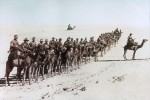BODEN, Samuel
Samuel Boden was born in Birmingham, England, but had lived in both India and Ceylon before he came to Australia. While in Sri Lanka, he had served for eighteen months with the Ceylon Planters Rifle Corps. It seems possible that these experiences shape the early part of his military career.
He was one of the first to enlist, signing up at Melbourne on August 24, 1914. At the time, he was a bookseller, single and living at 205 George St., East Melbourne. He appears to have had no relatives in Australia, giving his father, living at 179 Inkerman St., Birmingham, as his next of kin. After training he was attached to the 5th Battalion, leaving Melbourne on board HMAT 'Orvieto' on 21 October, 1914. After a brief stopover in Albany, Western Australia, waiting for other ships to join the convoy, the 'Orvieto' sailed on to Egypt.
There is no information on Samuel Boden's military record for the next few months, although the 5th Battalion took part ni the Anzac landing on April 25, forming part of the second wave of attack. Ten days after, they were moved to Cape Helles, where they were part of the disastrous attack on the village of Krithia and lost one third of their strength. From Cape Helles, they returned to defend the beach head at Anzac Cove, then fought in the battle of Lone Pine.
Samuel Boden, however, may well have been marked out as a special case, due to his experience in India and Sri Lanka. He must have been in some sort of training, because on 14 June, 1915, he was admitted to the No. 2 Field Ambulance station with concussion, and was then discharged the following day. On 17 August, he was training with the French Mortar Battery and then, on 2 February, 1916, was attached to the School of Instruction at Zeitoun, rejoining his unit at Serapeum on 28 February. On 3 March, he left his own unit to join the Bikaner Camel Corps, an Indian unit, which had been formed before the war, then sent to Egypt to defend the Suez Canal. They played a key role in the defence, when they routed Turkish troops in a cavalry charge. The Camel Corps grew to four brigades with the addition of British, Australian and NZ troops, one battalion each from Britain and New Zealand, two from Australia. In August, 1916, each company added a machine gun section of fifteen men, who alternated between fighting and holding the camels behind the lines. It was at this point that Samuel Boden was promoted to Lieutenant, presumably in charge of one of these sections. Two months later, he reverted to ranks, having been charged with overstaying his leave.
In August, he returned to be taken on strength at the Details Camp at Moascar. The Details Camp was an isolation camp, whose purpose was to screen the new recruits arriving in Egypt for ill-health. Samuel Bolden remained there until November, when he was discharged to go overseas. On 20 January, he was transferred into the 2nd Machine Gun Company. At the start of World War 1, each infantry battalion was issued with two, later four, machine guns. In February, 1916, the machine gun sections were brought together to form machine gun companies. Each company was allocated to a brigade and all were re-equipped with Vickers machine guns. The 2nd Machine Gun Battalion, to which Samuel Bolden was attached was formed in Egypt in March, 1916. Samuel Bolden may not have taken to the new company: on 25 January, 1917, he forfeited 7 days' pay for 'hesitating to obey an order'.
By now the 2nd Division were in France,. In February, they were engaging the German rearguard as they retreated towards the Hindenburg Line. By March, they were at the heavily fortified Hindenburg line. In April, they were fighting in the battle of Bullecourt and in July-August, in the 3rd Battle of Ypres. It is difficult to determine where Samuel Bolden was, but on 29 September, he was wounded in action with a shell or gunshot wound to his right elbow. By then, he had been appointed Lance-Corporal, but the wound marked the end of his military career. He was transferred back to England , where he was admitted to the 1st General Hospital at Stitchley on 9 October, 1917, before being transferred to the 3rd Auxiliary Hospital at Dartford. It mus have taken a long time to heal, but on 22 May 1918, he was finally sent back to Australia on board the 'Runic'.
No further record of him could be found: he does not feature on the Electoral Rolls or Census Records and there is no entry under Australian Births, Deaths and Marriages. Perhaps he went back to England.
Australian War Memorial, Embarkation Roll, Unit History
Australian National Archives, Service Record
Photographs: Wikipaedia 1) Imperial Camel Corps Brigade 2) Bikaner Camel Corps.


